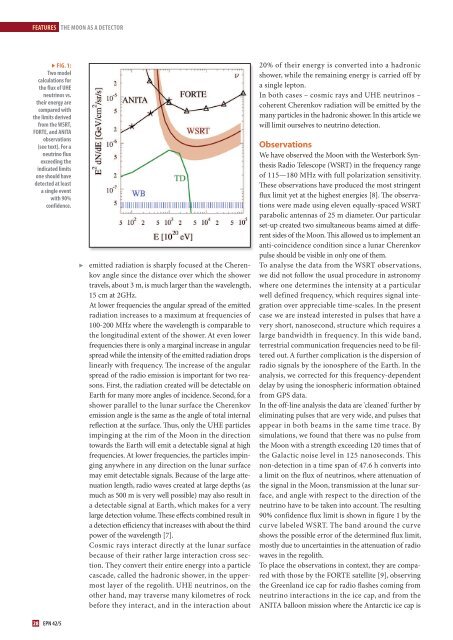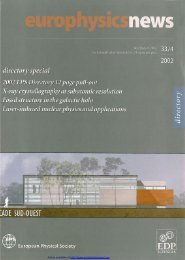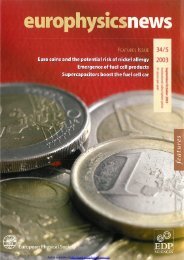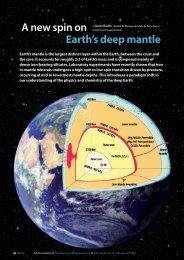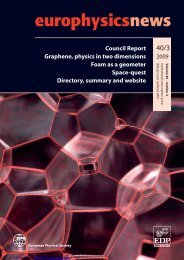PDF (11.37 MB) - Europhysics News
PDF (11.37 MB) - Europhysics News
PDF (11.37 MB) - Europhysics News
Create successful ePaper yourself
Turn your PDF publications into a flip-book with our unique Google optimized e-Paper software.
feaTureS THe moon aS a deTeCTor<br />
� fig. 1:<br />
Two model<br />
calculations for<br />
the flux of uHe<br />
neutrinos vs.<br />
their energy are<br />
compared with<br />
the limits derived<br />
from the wSrT,<br />
forTe, and aniTa<br />
observations<br />
(see text). for a<br />
neutrino flux<br />
exceeding the<br />
indicated limits<br />
one should have<br />
detected at least<br />
a single event<br />
with 90%<br />
confidence.<br />
28 EPN 42/5<br />
�<br />
emitted radiation is sharply focused at the Cherenkov<br />
angle since the distance over which the shower<br />
travels, about 3 m, is much larger than the wavelength,<br />
15 cm at 2GHz.<br />
At lower frequencies the angular spread of the emitted<br />
radiation increases to a maximum at frequencies of<br />
100-200 MHz where the wavelength is comparable to<br />
the longitudinal extent of the shower. At even lower<br />
frequencies there is only a marginal increase in angular<br />
spread while the intensity of the emitted radiation drops<br />
linearly with frequency. �e increase of the angular<br />
spread of the radio emission is important for two reasons.<br />
First, the radiation created will be detectable on<br />
Earth for many more angles of incidence. Second, for a<br />
shower parallel to the lunar surface the Cherenkov<br />
emission angle is the same as the angle of total internal<br />
reflection at the surface. �us, only the UHE particles<br />
impinging at the rim of the Moon in the direction<br />
towards the Earth will emit a detectable signal at high<br />
frequencies. At lower frequencies, the particles impinging<br />
anywhere in any direction on the lunar surface<br />
may emit detectable signals. Because of the large attenuation<br />
length, radio waves created at large depths (as<br />
much as 500 m is very well possible) may also result in<br />
a detectable signal at Earth, which makes for a very<br />
large detection volume. �ese effects combined result in<br />
a detection efficiency that increases with about the third<br />
power of the wavelength [7].<br />
Cosmic rays interact directly at the lunar surface<br />
because of their rather large interaction cross section.<br />
They convert their entire energy into a particle<br />
cascade, called the hadronic shower, in the uppermost<br />
layer of the regolith. UHE neutrinos, on the<br />
other hand, may traverse many kilometres of rock<br />
before they interact, and in the interaction about<br />
20% of their energy is converted into a hadronic<br />
shower, while the remaining energy is carried off by<br />
a single lepton.<br />
In both cases – cosmic rays and UHE neutrinos –<br />
coherent Cherenkov radiation will be emitted by the<br />
many particles in the hadronic shower. In this article we<br />
will limit ourselves to neutrino detection.<br />
Observations<br />
We have observed the Moon with the Westerbork Synthesis<br />
Radio Telescope (WSRT) in the frequency range<br />
of 115—180 MHz with full polarization sensitivity.<br />
�ese observations have produced the most stringent<br />
flux limit yet at the highest energies [8]. �e observations<br />
were made using eleven equally-spaced WSRT<br />
parabolic antennas of 25 m diameter. Our particular<br />
set-up created two simultaneous beams aimed at different<br />
sides of the Moon. �is allowed us to implement an<br />
anti-coincidence condition since a lunar Cherenkov<br />
pulse should be visible in only one of them.<br />
To analyse the data from the WSRT observations,<br />
we did not follow the usual procedure in astronomy<br />
where one determines the intensity at a particular<br />
well defined frequency, which requires signal integration<br />
over appreciable time-scales. In the present<br />
case we are instead interested in pulses that have a<br />
very short, nanosecond, structure which requires a<br />
large bandwidth in frequency. In this wide band,<br />
terrestrial communication frequencies need to be filtered<br />
out. A further complication is the dispersion of<br />
radio signals by the ionosphere of the Earth. In the<br />
analysis, we corrected for this frequency-dependent<br />
delay by using the ionospheric information obtained<br />
from GPS data.<br />
In the off-line analysis the data are 'cleaned' further by<br />
eliminating pulses that are very wide, and pulses that<br />
appear in both beams in the same time trace. By<br />
simulations, we found that there was no pulse from<br />
the Moon with a strength exceeding 120 times that of<br />
the Galactic noise level in 125 nanoseconds. This<br />
non-detection in a time span of 47.6 h converts into<br />
a limit on the flux of neutrinos, where attenuation of<br />
the signal in the Moon, transmission at the lunar surface,<br />
and angle with respect to the direction of the<br />
neutrino have to be taken into account. The resulting<br />
90% confidence flux limit is shown in figure 1 by the<br />
curve labeled WSRT. The band around the curve<br />
shows the possible error of the determined flux limit,<br />
mostly due to uncertainties in the attenuation of radio<br />
waves in the regolith.<br />
To place the observations in context, they are compared<br />
with those by the FORTE satellite [9], observing<br />
the Greenland ice cap for radio flashes coming from<br />
neutrino interactions in the ice cap, and from the<br />
ANITA balloon mission where the Antarctic ice cap is


